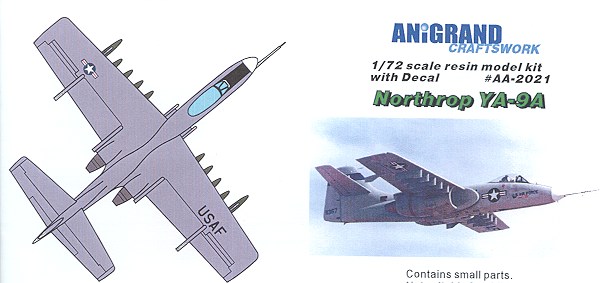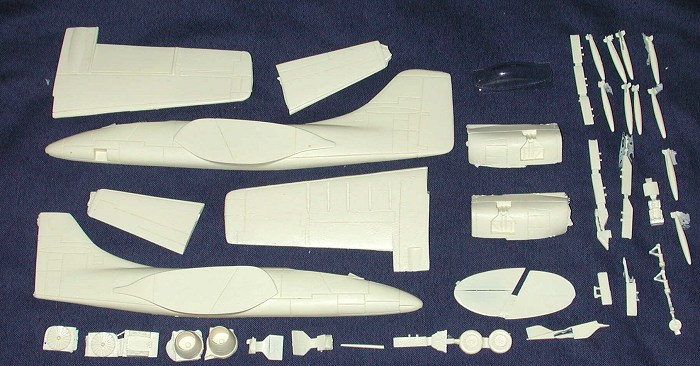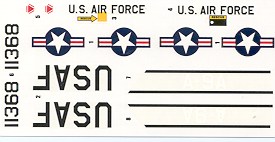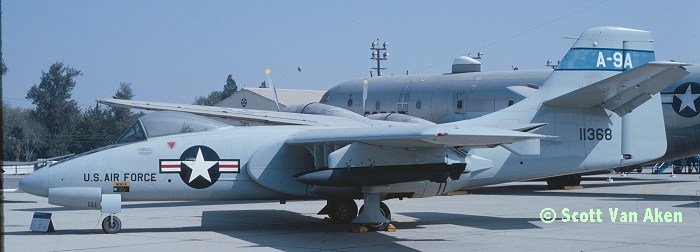
| KIT: | Anigrand 1/72 YA-9A |
| KIT # | AA-2021 |
| PRICE: | $58.00 MSRP |
| DECALS: | one option |
| REVIEWER: | Scott Van Aken |
| NOTES: | Short run resin kit with vac canopy |

| HISTORY |
The A-9 was designed by Northrop as a competitor for the ground attack aircraft competition for the Air Force in the mid 1970's. It was designed to provide extremely stable platform for bombing accuracy. It was also designed to be extremely durable and rugged since most of its flight time was to be spent close to the ground, in range of enemy guns. The twelve underwing pylons could carry almost all arms in Air Force inventory. All flight control systems were backed up by identical systems and all vital areas were protected with aluminum alloy armor of 1.25 to 2.5 inches. The competitor in the competition, and the aircraft chosen for production, was the A-10 Warthog, which gained fame in the Persian Gulf War as a tank killer. The A-9 was a very capable aircraft and it is curious that the Russian Su-25 Frogfoot ground attack aircraft looks very similar.
The two A-9A prototypes built had serial numbers 71-1367 and 71-1368. Both were designed and built for the AX Fly-Off Competition with the Fairchild Republic YA-10A "Thunderbolt II" (the two YA-10A prototype aircraft built were serial numbers 71-1369 & 71-1370), at the Air Force Flight Test Center at Edwards AFB, California. The first actual flight of the A-9A was on May 30th 1972, but the fly-off competition started on October 10th and concluded on December 9th, 1972. The AX Fly-Off was intended to identify the differences between the two aircraft in performance. The two aircraft were equally accurate in weapons delivery and in the gun tests. The gun that was supposed to be used for the fly-off was the General Electric GAU-8 "Avenger" 30mm cannon, but it was not ready in time to be used/tested for the fly-off. So a 20mm "Vulcan" cannon was used for the actual testing in both of the aircraft. A-9As 1367 & 1368 completed 123 flights, totaling 146.0 flight hours between the both of them. The two prototype YA-10As completed 87 flights totaling 138.5 flight hours. The YA-10A was selected the winner of the AX Fly-Off. After the fly-off was completed, the U. S. Air Force had no more use or interest in either of the two A-9As; they were transferred over to the NASA Dryden Research Center for flight testing before being completely retired from service.
Thanks to the March Field Museum for the historical background.
| THE KIT |

Anigrand is well known for producing American prototypes and this one is the first I can recall every seeing of the YA-9 in anything other than vacuformed plastic. Typical of Anigrand kits, this one has deep engraved panel lines; in fact they went a bit too deep for one of the splitter plates and it nearly cut it in half! Once it is installed, there should be no problem.
You get a pretty complete cockpit tub with seat, stick and instrument panel. Landing gear are resin and though they may give way under the weight of the kit after a few years, they are stubby and so may cause no problems. Gear doors are molded as one piece which the builder will cut to do the model gear down. The kit includes ten resin bomb racks which fit into slots in the underside of the wing. You also get 10 small bombs to attach to the racks should you wish. A few bombs had fins broken, but replacing them with those from the Hasegawa weapons set shouldn't be much of a problem.
Though this is still a bit of a rough kit along the edges, this particular one was not rife with air bubbles, gouges from broken off resin pour stubs, or short shot pieces. Sure, there are the usual areas of flash and cleanup is a bit more than on a Revell kit, but this is to be expected when working with resin. Though these kits are for experienced modelers, this one seems like it would be a good one for someone to do as their first involved resin kit. I'd like to think that Anigrand is taking quality control more seriously than just the luck of the draw. One thing that hasn't changed is the nearly invisible canopy frame lines. You will have to be very careful about masking and cutting as they are so very difficult to see. Finally, the plane is going to be tail heavy. You can see that from the get-go with all that airframe aft of the main wheels so be sure to cram as much weight as you can forward of the main gear. This may put a bit of extra stress on the resin moldings, but they seem as if they can handle it, thanks to being short.
 Instructions are the same as before and on a folded sheet of paper. One side has a short history, photo of the plane, parts list and an exploded view of the kit. The other is a nicely done three view that includes the painting and decal guide. The decals are well printed, a bit thick and very glossy. My experience is that they work well on relatively flat surfaces so they should work well with this aircraft as there are few compound curves to worry about. Thanks to the white paper background, the white markings are impossible to see until the decal is removed from the backing. One other note is that the tail band may well be blue instead of the grey that is mentioned in the instructions. Take a look at the preserved example from March AFB photographed in 1990 to see what I mean.
Instructions are the same as before and on a folded sheet of paper. One side has a short history, photo of the plane, parts list and an exploded view of the kit. The other is a nicely done three view that includes the painting and decal guide. The decals are well printed, a bit thick and very glossy. My experience is that they work well on relatively flat surfaces so they should work well with this aircraft as there are few compound curves to worry about. Thanks to the white paper background, the white markings are impossible to see until the decal is removed from the backing. One other note is that the tail band may well be blue instead of the grey that is mentioned in the instructions. Take a look at the preserved example from March AFB photographed in 1990 to see what I mean.

| CONCLUSIONS |
As with all short run kits, this one will require cleanup to get ready and some skill to build. However, the end result will be a most unusual aircraft that few modelers will have on their shelves.
Many thanks to DMC Models for the review kit. UPDATE: Nostalgic Plastic is now the US Importer for Anigrand. Please contact them for more information.
If you would like your product reviewed fairly and fairly quickly by asite that has over 250,000 visitors a month, please contactme or see other details in the